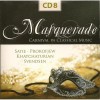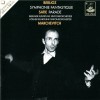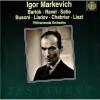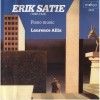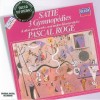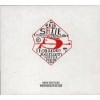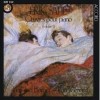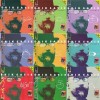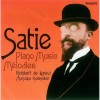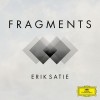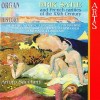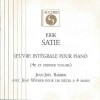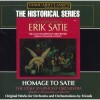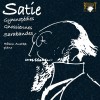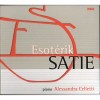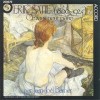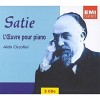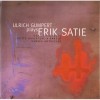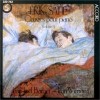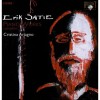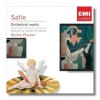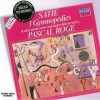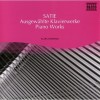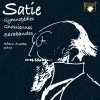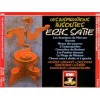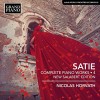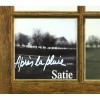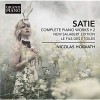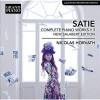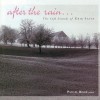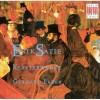| Country: | France |
| Period: | Impressionism |
Biography
From Normandy to Montmartre
Erik Satie's youth was spent alternating between living in Honfleur, Basse-Normandie, and Paris. When he was four years old, his family moved to Paris, his father (Alfred), having been offered a translator's job in the capital. After his mother (born Jane Leslie Anton, who was born in London to Scottish parents) died in 1872, he was sent, together with his younger brother Conrad, back to Honfleur, to live with his paternal grandparents. There he received his first music lessons from a local organist. When his grandmother died in 1878, the two brothers were reunited with their father in Paris, who remarried (a piano teacher) shortly afterwards. From the early 1880s onwards, Alfred Satie started publishing salon compositions (by his new wife and himself, among others).
In 1879 Satie entered the Paris Conservatoire, where he was soon labelled untalented by his teachers. After being sent home for two and a half years, he was readmitted to the Conservatoire at the end of 1885, but was unable to make a much more favourable impression on his teachers than he had before, and, as a result, resolved to take up military service a year later. However, Satie's military career did not last very long; within a few weeks he left the army through deceptive means.
In 1887 Satie left home to take lodgings in Montmartre. By this time he had started what was to be an enduring friendship with the romantic poet Patrice Contamine, and had had his first compositions published by his father. He soon integrated with the artistic clientèle of the Le Chat Noir Café-cabaret, and started publishing his Gymnopédies. Publication of compositions in the same vein (Ogives, Gnossiennes, etc.) followed. In the same period he befriended Claude Debussy. He moved to a smaller room, still in Montmartre (rue Cortot N° 6), in 1890. By 1891 he was the official composer and chapel-master of the Rosicrucian Order "Ordre de la Rose-Croix Catholique, du Temple et du Graal", led by Sâr Joséphin Péladan, which led to compositions such as Salut Drapeau!, Le Fils des étoiles, and the Sonneries de la Rose+Croix.
By mid-1892 he had composed the first pieces in a compositional system of his own making (Fête donnée par des Chevaliers Normands en l'Honneur d'une jeune Demoiselle), had provided incidental music to a chivalric esoteric play (two Prélude du Nazaréen), had had his first hoax published (announcing the premiere of Le Bâtard de Tristan, an anti-Wagnerian opera he probably never composed), and had broken with Péladan, starting that autumn with the Uspud project, a "Christian Ballet", in collaboration with Contamine de Latour. While the comrades from both the Chat Noir and Miguel Utrillo's Auberge du Clou sympathised, a promotional brochure was produced for the project, which reads as a pamphlet for a new esoteric sect.
Satie and Suzanne Valadon, an artists' model and artist in her own right, and a long-time friend of Miguel Utrillo (and mother of Maurice Utrillo), began an affair early in 1893. After their first night together, he proposed marriage. The two did not marry, but Valadon moved to a room next to Satie's at the Rue Cortot. Satie became obsessed with her, calling her his Biqui, and writing impassioned notes about "her whole being, lovely eyes, gentle hands, and tiny feet". During their relationship, Satie composed the Danses Gothiques as a kind of prayer to restore peace of mind, and Valadon painted a portrait of Satie, which she gave to him. After six months she moved away, leaving Satie broken-hearted. Afterwards, he said that he was left with "nothing but an icy loneliness that fills the head with emptiness and the heart with sadness". It is believed this was the only intimate relationship Satie ever had.
In the same year he met the young Maurice Ravel for the first time, Satie's style emerging in the first compositions of the youngster. One of Satie's own compositions of that period, the Vexations, was to remain undisclosed until after his death. By the end of the year he had founded the Eglise Métropolitaine d'Art de Jésus Conducteur (the Metropolitan Church of Art of the Leading Christ). As its only member, in the role of "Parcier et Maître de Chapelle" he started to compose a Grande Messe (later to become known as the Messe des Pauvres), and wrote a flood of letters, articles and pamphlets showing off his self-assuredness in religious and artistic matters. To give an example: he applied for membership of the Académie Française twice, leaving no doubt in the application letter that the board of that organisation (presided by Camille Saint-Saëns) as much as owed him such membership. Such proceedings without doubt rather helped to wreck his popularity in the cultural establishment. In 1895 he inherited some money, allowing him to have more of his writings printed, and to change from wearing a priest-like habit to being the "Velvet Gentleman".
Moving to Arcueil — cabaret compositions, Schola Cantorum
By mid-1896 all his financial means had vanished, and he had to move to cheaper lodgings, first at the Rue Cortot, to a room not much bigger than a cupboard, and two years later (after he'd composed the two first sets of Pièces froides in 1897), to Arcueil, a suburb some five kilometers from the centre of Paris (in the Val-de-Marne district of the Île-de-France).
At this period he re-established contact with his brother Conrad (in much the way Vincent van Gogh had with his brother Theo) for numerous practical and financial matters, disclosing some of his inner feelings in the process. The letters to Conrad made it clear that he had set aside any religious ideas (which were not to return until the last months of his life).
From the winter of 1898–1899, Satie could be seen, as a daily routine, leaving his apartment in the Parisian suburb of Arcueil to walk across Paris to either Montmartre or Montparnasse, before walking back again in the evening.
From 1899 on he started making money as a cabaret pianist (mostly accompanying Vincent Hyspa, later also Paulette Darty), adapting over a hundred compositions of popular music for piano (or piano and voice), adding some of his own. The most popular of these were Je te veux (text by Henry Pacory), Tendrement (text by Vincent Hyspa), Poudre d'or (a waltz), La Diva de l'"Empire" (text by Dominique Bonnaud/Numa Blès), Le Picadilly (A March), Légende Californienne (text by Contamine de Latour lost, but the music later reappears in La Belle Excentrique), and many more (probably even more have been lost). In his later years Satie would reject all his cabaret music as vile and against his nature (although he revived some of the fun of it in his 1920 Belle excentrique), but for the time being, it was an income.
Only a few compositions that Satie himself took seriously remain from this period: Jack-in-the-box, music to a pantomime by Jules Dépaquit (called a "clownerie" by Satie), Geneviève de Brabant, a short comic opera on a serious theme, text by Lord Cheminot, The Dreamy Fish, piano music to accompany a lost tale by Lord Cheminot, and a few others (mostly incomplete, hardly any of them staged, and none of them published at the time).
Both Geneviève de Brabant and The Dreamy Fish have been analysed (e.g. by Ornella Volta) as containing elements of competition with Claude Debussy, of which Debussy was probably not aware (Satie not making this music public). Meanwhile, Debussy was having one of his first major successes with Pelléas et Mélisande in 1902, leading a few years later to ‘who-was-precursor-to-whom’ debates between the two composers (in which Maurice Ravel would also get involved).
In October 1905 Satie enrolled in Vincent d'Indy's Schola Cantorum to study classical counterpoint (while still continuing his cabaret work). Most of his friends were as dumbfounded as the professors at the Schola when they heard about his new plan to return to the classrooms (especially as d'Indy was an admiring pupil of Saint-Saëns, not particularly favoured by Satie). As for Satie's motivation for this step, there were probably two main reasons: first, he was tired of being told that the harmonisation of his compositions was erratic (a criticism he could not very well counter, not having completed any studies in music), and secondly, he was developing the idea that one of the most typical characteristics of French music was clarity (which could better be achieved with a good background knowledge of how traditional harmony was perceived). Satie would follow these courses at the Schola, as a respected pupil, for more than five years, receiving a first (intermediate) diploma in 1908.
Some of his classroom counterpoint-exercises would, after his death, be published (e.g., the Désespoir agréable), but he probably saw the En Habit de Cheval (published in 1911 as the result of "eight years hard work to come to a new, modern fugue") as the culmination of the Schola episode. Another summary, of the period prior to the Schola, also appeared in 1911: the Trois Morceaux en forme de poire, which was a kind of compilation of the best of what he had written up to 1903.
Something that becomes clear through these published compilations is that maybe he did not so much reject Romanticism (and its exponents like Wagner) as a whole (he has become more moderate in a way), as that he rejected certain aspects of it: musically the thing he rejected most consequently, from his very first composition to his very last, was the idea of development, certainly in the more strict definition of this term: the intertwining of different themes in a development section of a sonata form: naturally this makes his contrapuntal (and other works) very short: e.g. the "new, modern" Fugues do not extend further than the exposition of the theme(s). Generally he would say that he did not think it permitted that a composer would take more time from his public than strictly necessary, certainly avoiding being boring in any way. Also Melodrama, in its historical meaning of the then popular romantic genre of "spoken words to a background of music", was something Satie appears to have succeeded quite well in staying clear of (although his 1913 Piège de Méduse could be seen as an absurdistic spoof of that genre).
In the meantime, other changes had also taken place: Satie had become a member of a radical (socialist) party, had socialised with the Arcueil community (amongst other things, he'd been involved in the "Patronage Laïque" work for children), and he had changed his appearance to that of the 'bourgeois functionary' (with bowler hat, umbrella, etc.). Also, instead of involving himself again in any kind of medievalist sect, he channelled these interests into a peculiar secret hobby: in a filing cabinet he maintained a collection of imaginary buildings (most of them described as being made out of some kind of metal), which he drew on little cards. Occasionally, extending the game, he would publish anonymous small announcements in local journals, offering some of these buildings (e.g., a "castle in lead") for sale or rent.
Riding the waves
From this point, things started to move very quickly for Satie. First, there was, starting in 1912, the success of his new "miniature", humorous piano pieces; he was to write and publish many of these over the next few years (most of them premiered by the pianist Ricardo Viñes): the Véritables Préludes flasques (pour un chien) ("Genuine Flaccid Preludes (for a dog)"), the Vieux sequins et vieilles cuirasses ("Old Sequins and Old Breastplates"), the Embryons desséchés ("Dessicated Embryos"), the Descriptions Automatiques, and the Sonatine Bureaucratique (a Muzio Clementi spoof), etc., all date from this period. His habit of accompanying the scores of his compositions with all kinds of written remarks was now well established (so that a few years later he had to insist that these not be read out during performances). He had mostly stopped using barlines by this time. In some ways these compositions were very reminiscent of Rossini's compositions from the final years of his life, grouped under the name Péchés de Vieillesse.
But the real acceleration in Satie's life did not come so much from the increasing success of his new piano pieces. In fact, it was Ravel who (perhaps unwittingly) triggered something that was to become a characteristic of Satie's remaining years and part of each progressive movement that manifested itself in Paris over the following years. These movements succeeded one another rapidly, at a time in which Paris was seen as the artistic capital of the world (long before London or New York would achieve much significance in this regard), and the beginning of the new century appeared to have set many minds on fire.
In 1910 the "Jeunes Ravêlites", a group of young musicians around Ravel, proclaimed their preference for Satie's earlier work (from before the Schola period), reinforcing the idea that Satie had been a precursor of Debussy. At first Satie was pleased that at least some of his works were receiving public attention, but when he realised that this meant that his more recent work was overlooked or dismissed, he looked for other young artists who related better to his more recent ideas, so as to have better mutual support in creative activity. Thus young artists such as Roland-Manuel, and later Georges Auric, and Jean Cocteau, started to receive more of his attention than the "Jeunes".
As a result of his contact with Roland-Manuel, Satie again began publicising his thoughts, with far more irony than he had done before (amongst other things, the Mémoires d'un amnésique and Cahiers d'un mammifère).
With Jean Cocteau, whom he had first met in 1915, Satie started work on incidental music for a production of Shakespeare's A Midsummer Night's Dream (resulting in the Cinq Grimaces). From 1916, he and Cocteau worked on the ballet Parade, which was premiered in 1917 by Sergei Diaghilev's Ballets Russes, with sets and costumes by Pablo Picasso, and choreography by Léonide Massine. Through Picasso Satie also became acquainted with other cubists, such as Georges Braque, with whom he would work on other, aborted, projects.
With Georges Auric, Louis Durey, Arthur Honegger, and Germaine Tailleferre Satie formed the Nouveaux Jeunes, shortly after writing Parade. Later the group was joined by Francis Poulenc and Darius Milhaud. In September 1918, Satie — giving little or no explanation — withdrew from the Nouveaux Jeunes. Jean Cocteau gathered the six remaining members, forming the Groupe des Six (to which Satie would later have access, but later again would fall out with most of its members).
From 1919 Satie was in contact with Tristan Tzara, the initiator of the Dada movement. He became acquainted with other artists involved in the movement, such as Francis Picabia (later to become a Surrealist), André Derain, Marcel Duchamp, Jean Hugo and Man Ray, among others. On the day of his first meeting with Man Ray, the two fabricated the artist's first readymade: The Gift (1921). Satie contributed writing to the Dadaist publication 391. In the first months of 1922 he was surprised to find himself entangled in the argument between Tzara and André Breton about the true nature of avant-garde art, epitomised by the failure of the Congrès de Paris. Satie originally sides with Tzara, but manages to maintain friendly relations with most players in both camps. Meanwhile, an "Ecole d'Arcueil" had formed around Satie, with young musicians like Henri Sauguet, Maxime Jacob, Roger Désormière and Henri Cliquet-Pleyel.
Finally he composed an "instantaneist" ballet (Relâche) in collaboration with Picabia, for the Ballets Suédois of Rolf de Maré. In a simultaneous project, Satie added music to the surrealist film Entr'acte by René Clair, which was given as an intermezzo for Relâche.
Other work and episodes in this last period of Satie's life:
* Since 1911 he had been on friendly terms with Igor Stravinsky, about whom he would later write articles.
* Le Piège de Méduse (1913) had a unique position in Satie's oeuvre, as it was a stage work conceived and composed seemingly without any collaboration with other artists.
* Sports et divertissements was a kind of multi-media project, in which Satie provided piano music to drawings made by Charles Martin. The work was composed in 1914, but not published or performed until the early 1920s. The individual pieces are characteristic Satie "miniatures": in all, there are twenty pieces - none over two minutes in length, and some as short as 15 seconds.
* He got in trouble over an insulting postcard he had written to one of his critics shortly after the premiere of Parade; he was condemned to a week of imprisonment, but was finally released as a result of the (financial) intercession of Winnaretta Singer, Princess Edmond de Polignac.
* Singer, who had learnt Ancient Greek when she was over 50, had commissioned a work on Socrates in October 1916; this would become his Socrate, which he presented early in 1918 to the Princess.
* From 1917 Satie wrote five pieces of furniture music ("Musique d'ameublement") for different occasions.
* From 1920, he was on friendly terms with the circles around Gertrude Stein, amongst others, leading to the publication of some of his articles in Vanity Fair (commissioned by Sibyl Harris).
* Some works would originate under the patronage of the count Etienne de Beaumont, from 1922 onwards:
o La Statue retrouvée (or "Divertissement"): another Satie-Cocteau-Picasso-Massine collaboration.
o Ludions: a setting of nonsense rhyme by Léon-Paul Fargue
o Mercure: the subtitle of this piece ("Poses plastiques") suggests it might have been intended rather as an emulation of the tableau vivant genre than as an actual ballet, the "tableaux" being cubist, by Picasso (and Massine).
* During his final years Satie travelled; for example, in 1924 to Belgium, invited by Paul Collaer, and to Monte Carlo for the premiere of a work on which he had collaborated.
Epilogue: the shrine of Arcueil
At the time of Satie's death in 1925, absolutely nobody else had ever entered his room in Arcueil since he had moved there twenty-seven years earlier. What his friends would discover there, after Satie's burial at the Cimetière d'Arcueil, had the allure of the opening of the grave of Tutankhamun; apart from the dust and the cobwebs (which, among other things, made clear that Satie never composed using his piano), they discovered numerous items that included:
* great numbers of umbrellas, some that had apparently never been used by Satie,
* a total of four pianos: two of which were back to back, two of which sat upside-down on top of the other two
* the portrait of Satie by Suzanne Valadon,
* love-letters and drawings from the Valadon romance,
* other letters from all periods of his life,
* his collection of drawings of medieval buildings (only then did his friends see a link between Satie and certain previously anonymous, journal advertisements regarding "castles in lead" and the like),
* other drawings and texts of autobiographical value,
* other memorabilia from all periods of his life, amongst which were the seven velvet suits from his Velvet gentleman period.
Additionally, there were compositions that were totally unknown or which were thought to have been lost. They were found behind the piano, in the pockets of the velvet suits, and in other odd places. These included the Vexations, Geneviève de Brabant, and other unpublished or unfinished stage works, The Dreamy Fish, many Schola Cantorum exercises, a previously unseen set of "canine" piano pieces, several other piano works, often without a title. Some of these works would be published later as more Gnossiennes, Pièces Froides, Enfantines, and Furniture music).







![Deutsche Grammophon Classic Gold [CD 1 of 3]](http://static.classicalm.com/repository/collection-cover/small/1314-img1361380277394437.jpg)
![Top 100 der Klassik [CD 2 of 5]](http://static.classicalm.com/repository/collection-cover/small/1365-img1372592354874210.jpg)


